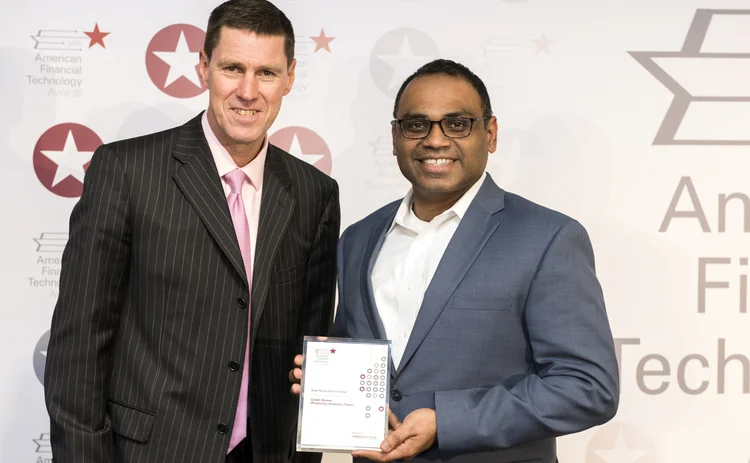AFTAs 2018: Best Analytics Initiative—Credit Suisse

Artificial intelligence (AI) may be all the rage at the moment, but less-often mentioned is a subset-of-a-subset on the bleeding edge of technological development—deep learning. Here, Credit Suisse shines for delivering actionable insights based on its work in natural-language processing and deep learning, via its analytics platforms, and wins the AFTA for its efforts.
One of the major problems facing equities research analysts isn’t necessarily information shortage—it’s too much information. The volume of emails and notes both generated and received by staff on these teams is immense—in Credit Suisse’s case, its Global Markets Equities Research Team has to deal with over 3 million emails and 500,000 meeting notes—but finding an efficient way to analyze these client communications has always been challenging.
Enter AI. The goal of the project was to deliver insights around four main areas: topic modeling, in which potential sales ideas could be generated around stocks or bonds that may be potentially of interest to clients; ticker tagging, in order to identify said instruments for future reference; contact-level sentiment analysis, to determine overall perception of products and services; and auto-summarization, which would enable the machine-learning algorithm to generate commentary on a client.
Implementing this required an element of trial-and-error at first, partly because this is breaking such new ground within actual implementations of machine-learning technology. “We tried various models, such as random forest and a few others, and we obviously wanted to give deep learning a shot because we had enough data to try this out,” says Paras Parekh, head of the predictive analytics team within the global markets technology group at Credit Suisse. “It happens that the deep learning model works fairly well compared to random forest.”
The work so far has resulted in the development of two dashboards which, the bank says, have generated “actionable insight.” The first displays an email or meeting note which has been through the algorithm, cleaned and tagged appropriately, along with sentiment. The second displays time-series data at a contact level, and the top entities by mention, as well as trends by sentiment score. All of this, too, while the platform is still effectively being built.
“We’re still fine-tuning the model. It’s giving us enough insight, but there’s still some work needed, especially when we’re looking to find cross-selling opportunities,” says Parekh. “But if we had to look for investment ideas for stocks that the client may be interested in, that’s working quite well. We’re also able to do a fair bit of entity recognition and trying to understand all the various entities involved for an individual or within a group at a client level or a macro level.”
Only users who have a paid subscription or are part of a corporate subscription are able to print or copy content.
To access these options, along with all other subscription benefits, please contact info@waterstechnology.com or view our subscription options here: http://subscriptions.waterstechnology.com/subscribe
You are currently unable to print this content. Please contact info@waterstechnology.com to find out more.
You are currently unable to copy this content. Please contact info@waterstechnology.com to find out more.
Copyright Infopro Digital Limited. All rights reserved.
As outlined in our terms and conditions, https://www.infopro-digital.com/terms-and-conditions/subscriptions/ (point 2.4), printing is limited to a single copy.
If you would like to purchase additional rights please email info@waterstechnology.com
Copyright Infopro Digital Limited. All rights reserved.
You may share this content using our article tools. As outlined in our terms and conditions, https://www.infopro-digital.com/terms-and-conditions/subscriptions/ (clause 2.4), an Authorised User may only make one copy of the materials for their own personal use. You must also comply with the restrictions in clause 2.5.
If you would like to purchase additional rights please email info@waterstechnology.com
More on Awards & Rankings
Witad Awards 2025 winner’s interview: Maureen Downs (Connamara Technologies)
Video interview with Connamara Technologies co-founder, and winner of the trailblazer vendor category in the 2025 Witad Awards, Maureen Downs
Buy-Side Technology Awards 2024 winner’s interview: FactSet
Video discussion on FactSet’s trio of wins in the 2024 BST Awards
Witad Awards 2025: Vendor professional of the year (business development)—Ripple Bhullar, Kyndryl
Ripple Bhullar, vice president, head of US capital markets and diversified, at Kyndryl, wins vendor professional of the year (business development) in the 2025 Women in Technology and Data Awards.
Witad Awards 2025: Technology leader of the year (vendor)—Mary Cecola, Broadridge Financial Solutions
Mary Cecola, CTO for asset management at Broadridge Financial Solutions, wins technology leader of the year (vendor) in the 2025 Women in Technology and Data Awards.
Witad Awards 2025: Trailblazer (Lifetime achievement) award (vendor)—Maureen Downs, Connamara Technologies
Maureen Downs, co-founder and chair of Connamara Technologies, wins the Trailblazer (Lifetime achievement) award (vendor) in the 2025 Women in Technology and Data Awards.
Witad Awards 2025: Legal/compliance professional of the year—Devi Shanmugham, Tradeweb
Devi Shanmugham, global head of compliance at Tradeweb, wins legal/compliance professional of the year in the 2025 Women in Technology and Data Awards.
Witad Awards 2025: Technology innovator of the year (end-user)—Ruchi Acharya Saraswat, RBC Capital Markets
Ruchi Acharya Saraswat, managing director, head of strategy and transformation, business and client services technology at RBC Capital Markets, wins technology innovator of the year (end-user) in the 2025 Women in Technology and Data Awards.
Witad Awards 2025: Best company for diversity and inclusion (end-user)—BNP Paribas Portugal
BNP Paribas Portugal wins best company for diversity and inclusion (end-user) in the 2025 Women in Technology and Data Awards.


